Stockholm has lots of islands and lots of enticing museums. This past summer a travel companion and I spent a few days getting acquainted with a few of each.
Parts of Sweden’s capital were built on 14 islands, located on the east coast of Sweden. Most tourist visits center on very few of those islands: The must-visit City Hall is dramatically sited on the pointy end of Kungsholmen; the Old Town actually is an island called Gamla Stan, site of the Royal Palace and Stockholm Cathedral, and Djurgarden is a little hotbed of popular museums.
Viking Museum
My friend and I arrived on the afternoon of a rainy crappy-skies day so it was museum time. We headed to Djurgarden and got a bit lost on the island, but we found the Viking Museum.
The small facility, which debuted in 2017, has lots of interactive elements and signage meant to paint a reasonably realistic picture of the life and times of people known to us as Vikings.
We were greeted at the museum by a costumed ticket seller, who smiled and posed for photos, but didn’t sell me a ticket. I was using an inclusive city pass; Stockholm’s Go City pass, for a single price, admits its holder to a raft of museums and activities (and that’s pretty handy).
My friend and I went straight for the “adventure ride” called “Ragnfrid’s Saga.” This is an audiovisual presentation that involves riding in cars, much as at a carnival, from one point to another, in this case to see dioramas that illustrate each element of the fictional story of a 10th century man called Harald (Ragnfrid is his wife), who has to become a marauding Viking to capture riches and support his family. His travels take him as far as Constantinople (now Istanbul) for a sighting of Hagia Sophia. Each museum visitor chooses the language to be piped into his/her car.
Although this saga is fiction, the tale is based on true stories and experiences of folks in Viking times. The “adventure” also was fun and a good chance to sit for a while before walking around the museum.
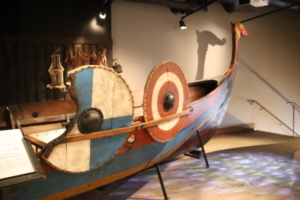
On exhibit at the Viking Museum, the recreated version of a Viking dragon ship, adorned with shields on the side. The name comes from the dragon head represented on the prow
Displays included a sample of what a brightly painted Viking ship would have looked like, games and other artifacts found at archaeological digs, models of meeting rooms and temples plus holograms of men and women in the types of clothing that Vikings would have worn, depending on wealth and position in life.
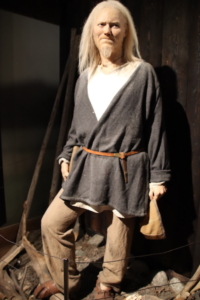
Reconstruction of a Viking man, who died when he was 45 to 60 in the late 10th or early 11th century. His grave was found in Sigtuna, north of Stockholm, and reconstruction was based on osteological analyses.

Small model of a Viking pagan temple. The original was found in Uppakra in southern Sweden.
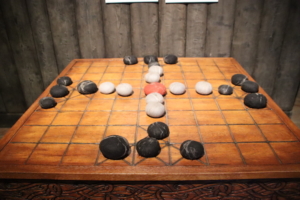
Model for a Viking board game called hnefatafl, a game that seems to have enjoyed the same kind of status that chess does today.
The information boards on the walls shared fun facts like these: The average height for a Viking man was 5 feet, 7 inches, for the woman, 5 feet, 3 inches. The diet was mostly vegetarian because meat was expensive. Childhood ended at around age 12. Oh, and, Vikings left graffiti on the walls of Hagia Sophia.
Another fun fact is of special interest to me: The Viking Age is said to have extended from around 800 to 1066, the year the Norwegian king, Harald Hradrada, lost his bid to take the throne from England’s King Harold, the latter sometimes identified as Harold Godwin (my surname) or Godwinson.
Moving on from the Vikings but remaining on Djurgarden island, the Museum of Spirits (meaning the liquid kind) sounded amusing, but it was too late in the day for that. We did have time for the ABBA Museum — or so it seemed until we saw the line that went on forever. We went to dinner.
Vasa Museum
We came back to Djurgarden island on another day for one of Stockholm’s most-visited attractions, the Vasa Museum.
This is essentially a single cavernous hall built to accommodate and preserve a 17th century wooden warship called the Vasa that was large enough to house 450 boys and men (not comfortably, mind you).
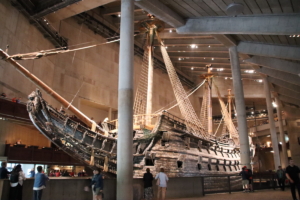
Above. The 17th century Vasa seen at ground floor level of the Vasa Museum. Below, Vasa seen at a higher viewing level. The photos give some indication of how large the ship is.
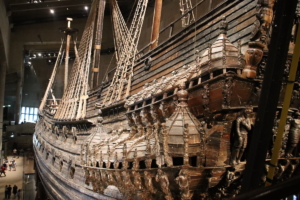
The thing is, the Vasa sank in the Stockholm harbor 20 minutes after its launch in August 1628. It went down in water 100 feet deep, drowning around 30 people including at least one woman. The vessel was rediscovered in the 1950s and brought out of the water, pretty much in one piece, in 1961, 333 years after it sank. It then took 18 years to treat and preserve the ship’s wood.
The Vasa fared incredibly well (it is 98% original) because worms that would destroy the wood cannot live in the salty Baltic.
The ship is remarkable for its size and for, believe it or not, beauty. It is so tall, we looked at it on the ground floor and from viewing floors at five other levels.
And we could see this was a fabulous-looking ship when it launched — it was decorated with more than 700 brightly painted sculptures. The wooden sculptures are in position, but all that color is gone. As compensation, the museum displays some full-sized reproductions of sample sculptures and a small model of the entire ship to indicate how the original colors looked.
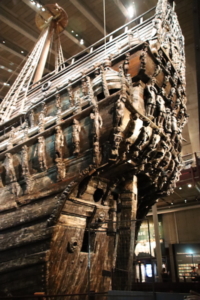
Above, a closer look at the numerous sculptures that decorate the Vasa’s prow. Below, a small reproduction of the ship designed to show how the ship must have looked just before it sank in 1628.

My companion and I managed to join a free 25-minute English-language guided tour, then sat in on a short film about the ship (English subtitles). The tour was loaded with juicy tidbits (some included above), and I loved the film’s reimagining of 17th century Stockholm, its people and housing, the finished ship and its collapse.
City Hall
We made two visits to City Hall, the first a viewing of the exterior during a city tour. A century old this year (2023), it is a huge red brick building inspired by Italian palaces and city halls, with one very tall tower. To emphasize the connection to medieval models, every brick in the building was made by hand.
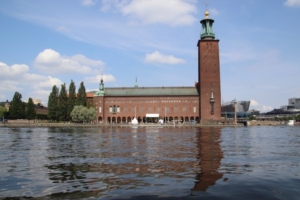
Stockholm City Hall seen from the Stromma boat tour.
Our guide said dozens of weddings occur in City Hall each Saturday. The long ceremony lasts three minutes and the short lasts 45 to 60 seconds depending on how fast everyone talks, she quipped.
We came back early (8:30 a.m.) another day aiming to buy tickets for the 10 a.m. English-language guided tour inside the building. What idiots!
On this peak-season June day, the line for tickets snaked around inside a large open-air courtyard and out onto the sidewalk, and, it turned out, there would be only 35 tickets for each of six English-language tours for the day.

Entry courtyard to the City Hall, where hundreds of visitors waited for a chance at a relatively few tickets for guided tours of the interior.
But we could, and did, opt for free entry to the Blue Hall, site of the Nobel Prize banquet each Dec. 10, and the Golden Hall, a large (6,458 square feet) hall, used for banquets and concerts.
The Blue Hall is really a large covered courtyard, and it gets its name from the architect’s original intent to paint the walls blue. He changed his mind after he saw and liked the look of the handmade red bricks.
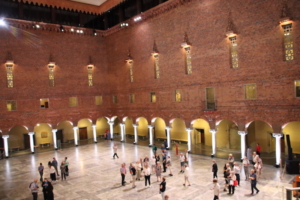
City Hall’s Blue Room, the covered courtyard that never got its coat of paint. It is the setting for the annual Nobel Prize gala dinner.
And the Golden Hall is decorated corner to corner with vignettes telling stories from Sweden’s history. The medium is mosaics, including almost 18 million golden tiles. This is a jaw-dropping room to explore — and there was no one hustling us to move along.

Above and below, the City Hall’s Golden Room, covered in golden mosaics and a series of vignettes that tell the story of Stockholm.
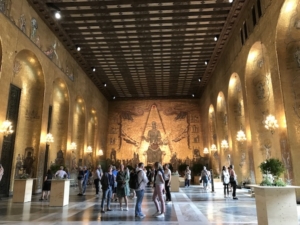
Boat tour
When our Stockholm sojourn became sunny and hot, we went to sea. More precisely, we joined a two-hour, 15-minute boat trip among the city’s several islands; the trip, operated by Stromma, was called Under the Bridges of Stockholm. The boat was enclosed (good cover under hot sun) but with open windows (good for photos).
I pretty much took photos of everything that looked reasonably photogenic and had sun on it — for 176 shots, more than one per minute!!

Above, view of Riddarholmen, a tiny island next to Gamla Stan (Old Town), seen from the boat tour. Below, further images caught during the boat tour, colorful houses near the water line, pleasure boats from one end of the horizon to the other and a waterside warehouse, irresistible with its vivid red paint job.


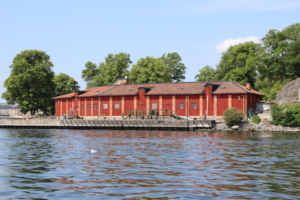
We all had earplugs and could choose our language for listening to a recorded narration. Despite the narrative, it was often hard to visualize where we were, but I did not worry about that too much.
We did, however, hear about some rather blood-curdling episodes in Sweden’s capital city:
A) Stockholm Bloodbath, 1520, when Danish King Christian II (reigned 1513–23) slaughtered some 80 or so Swedish nobles. That brought on the final phase of a Swedish war of secession from a union of three Scandinavian countries (Denmark, Norway and Sweden), producing the stand-alone Swedish kingdom in 1523. Sweden has been celebrating the 500th anniversary of that independence all this year, 2023.

About those vignettes in City Hall, this one illustrates the so-called Stockholm Bloodbath. A figure at upper right appears to be ready to do in the figure at left, and below are two bodies flowing in water. Grim stuff.
B) The Great Noise, a frenzy of witch trials (1668-1676) that left around 300 people, mostly women, dead and makes the Salem witch trials of 1692, during which 19 people and two dogs were executed, look mild.
C) Black Death. The 1710-1711 outbreak killed one third of the Stockholm population.
It’s amazing how this kind of info sticks in the mind.
Gamla Stan
The island location of Stockholm’s birthplace was on our guided tour.
Our stroll that day took us through a warren of sweet little streets plus squares that weren’t square, and then we landed at Stortorget (Grand Square) in the heart of Old Town. Suddenly, I recognized a line of houses from my only previous visit to Stockholm, in December 1990, when the square was abuzz with a Christmas market.
During this summer’s guided tour, it was a rainy mess so my friend and I returned to the Old Town two days later under sunny skies (after the boat tour). I knew what I wanted — an outdoor lunch in Stortorget with a full view of the remembered charming houses. Which is why we ate at a perfectly situated restaurant called Stortorgkallaren. Furthermore, I did not have to turn my head very much to look at the Nobel Prize Museum, the former Stock Exchange Building. And, oh yes, the food was good.
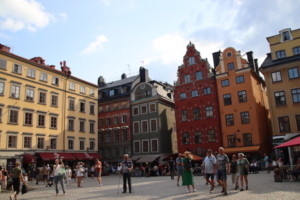
Stortorget (Grand Square), in the heart of Old Town, site of a Christmas market when I first saw it in 1990. Our lunch site this year was under the red awning at left.

The Nobel Prize Museum, also on Stortorget in Old Town.
After lunch, I had time for the Royal Palace. As a bonus, this year, the palace devoted a piece of its exhibit space to celebrate the Golden Jubilee of Sweden’s King Carl Gustaf, who was crowned in 1973. (You will note, lots of anniversaries for one year.)

The Royal Palace, not far from Stortorget in Stockholm’s Old Town.
However, I’m not very interested in indoor tourism when the weather beyond the doors is perfect. Skipping the palace, I chewed up a couple of hours walking all over Gamla Stan taking pictures and looking down every side street.

Above and below, scenes from a leisurely stroll from one end of Gamla Stan to the other. The sculpture in last photo is “St. George Killing the Dragon,” a copy of a more colorful version found inside Stockholm Cathedral.
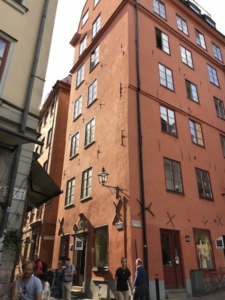
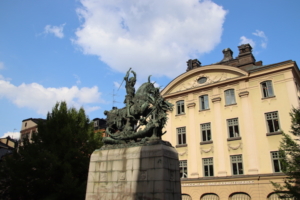
What a good deal that all those digital photos are free (after buying the camera)!
For more information about Stockholm, we offer at BestTripChoices.com the following, under the headline, ‘Scandinavia’s capital,’ https://besttripchoices.com/stockholm-sweden/
This blog and its photos are by Nadine Godwin, BestTripChoices.com editorial director and contributor to the trade newspaper, Travel Weekly. She also is the author of “Travia: The Ultimate Book of Travel Trivia.”
